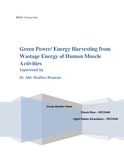| dc.contributor.advisor | Rhaman, Md. Khalilur | |
| dc.contributor.author | Dhar, Palash | |
| dc.contributor.author | Khandakar, Ajijul Hakim | |
| dc.date.accessioned | 2013-06-11T06:34:07Z | |
| dc.date.available | 2013-06-11T06:34:07Z | |
| dc.date.copyright | 2013 | |
| dc.date.issued | 2013-04-27 | |
| dc.identifier.other | ID 09221048 | |
| dc.identifier.other | ID 09221036 | |
| dc.identifier.uri | http://hdl.handle.net/10361/2591 | |
| dc.description | This thesis report is submitted in partial fulfillment of the requirements for the degree of Bachelor of Science in Electrical and Electronic Engineering, 2013 | |
| dc.description | Cataloged from PDF version of thesis report. | |
| dc.description | Includes bibliographical references (page 31-32). | |
| dc.description.abstract | As a developing country ours one is not like others, concerning electricity problems. The main issue with the point of view of electrical energy and its sources is lack of generation of electricity. It is happening because of our limitation of technology in the field of electricity. Though renewable energy is introduced, the impact of this new technology is not significant. This is why we are concern on electricity harvesting through human wastage energy. We will use pressure energy to harvest electricity by introducing a mechanism. This pressure energy is taken from the movement of human body. Actually we are trying to introduce such a mechanism through which the electricity problem of Bangladesh will be reduced significantly.The process of acquiring the energy surrounding a system and converting it into usable electrical energy is termed power harvesting. In the last few years, there has been a surge of research in the area of power harvesting. This increase in research has been brought on by the modern advances in wireless technology and low-power electronics such as micro-electromechanical systems. The advances have allowed numerous doors to open for power harvesting systems in practical real-world applications. The use of piezoelectric materials to capitalize on the ambient vibrations surrounding a system is one method that has seen a dramatic rise in use for power harvesting. Piezoelectric materials have a crystalline structure that provides them with the ability to transform mechanical strain energy into electrical charge and, vice versa, to convert an applied electrical potential into mechanical strain. This property provides these materials with the ability to absorb mechanical energy from their surroundings, usually ambient vibration, and transform it into electrical energy that can be used to power other devices. While piezoelectric materials are the major method of harvesting energy, other methods do exist; for example, one of the conventional methods is the use of electromagnetic devices. In this paper we discuss the research that has been performed in the area of power harvesting and the future goals that must be achieved for power harvesting systems to find their way into everyday use.On our project we will be trying to do this combination to harvest more energy. | en_US |
| dc.description.statementofresponsibility | Palash Dhar | |
| dc.description.statementofresponsibility | Ajijul Hakim Khandakar | |
| dc.language.iso | en | en_US |
| dc.publisher | BRAC University | en_US |
| dc.rights | BRAC University thesis are protected by copyright. They may be viewed from this source for any purpose, but reproduction or distribution in any format is prohibited without written permission. | |
| dc.subject | Green Power | en_US |
| dc.subject | Electrical and electronic engineering | |
| dc.title | Green power / energy harvesting from wastage energy of human muscle activities | en_US |
| dc.type | Thesis | en_US |
| dc.contributor.department | Department of Electrical and Electronic Engineering, BRAC University | |
| dc.description.degree | B. Electrical and Electronic Engineering | |

